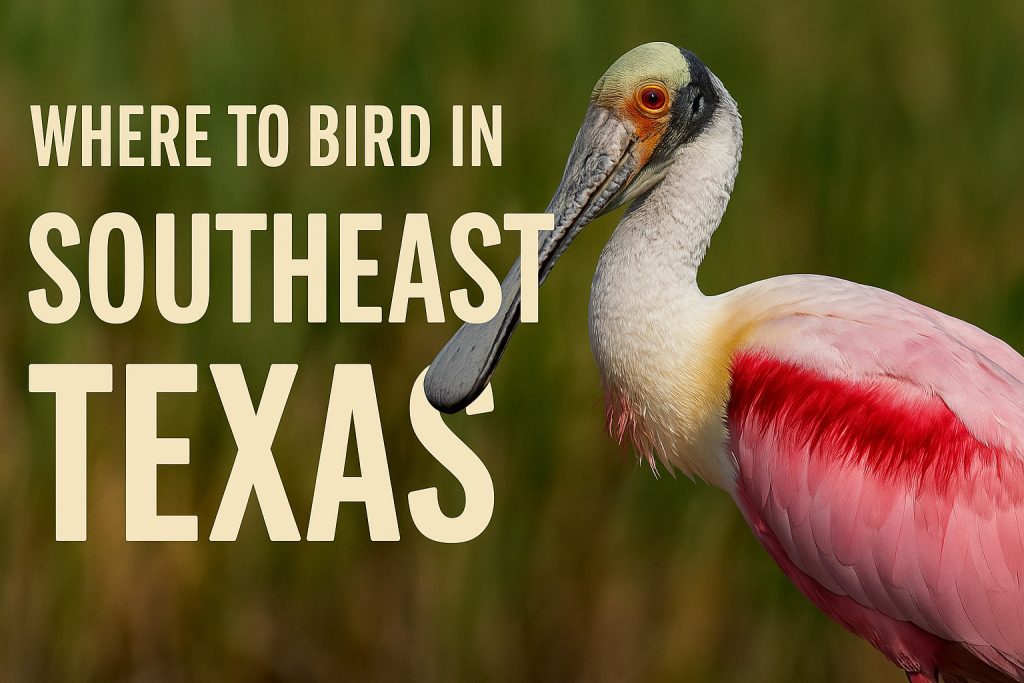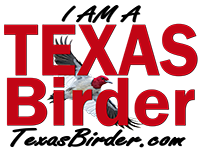
Before you grab your binocs and chase that next lifer, just a quick note: this list highlights some of the most popular birding locations in the region, with only the basics to get you started. Think of it as a beginner’s guide for your next birdy road trip. We’re working on adding even more locations, juicy details, seasonal tips, and probably a few “you had to be there” birder stories. And hey—if you’re out exploring Texas, keep an eye out for Michael in the Texas Birder camper. He’s crisscrossing the state one birding hotspot at a time, likely parked under a tree with a notebook, a camera, and an opinion about vireos.
Welcome to Southeast Texas, where the birds are loud, the air is humid enough to style your hair for you, and the birding is nothing short of phenomenal.
From marshes that hum with life to world-renowned migration hotspots that send warbler-chasers into a frenzy, this region is a birder’s dream. So grab your binoculars (and maybe a towel), because we’re headed into one of the richest birding regions in all of North America—and yes, there will be roseate spoonbills.
1. High Island (Houston Audubon Sanctuaries)
Location: Near the Gulf Coast, between Winnie and the ocean
Habitats: Oak mottes, salt marsh, coastal prairie
Hotspots: Boy Scout Woods, Smith Oaks, Hook’s Woods, and the rookery
What You’ll See:
- Warblers in colors that make your camera cry
- Tanagers, orioles, grosbeaks, and cuckoos (oh my!)
- Neotropic Cormorants and Roseate Spoonbills nesting at eye level
- That birder who swears she saw a Swainson’s Warbler but didn’t get a photo
Why It’s Great:
Spring migration here is a world-famous phenomenon. One moment, you’re standing in silence. The next? A “fallout” drops hundreds of songbirds into the trees. Bring snacks, water, and a notebook to write down all your new life birds—and possibly your new life purpose.
2. Anahuac National Wildlife Refuge
Location: Chambers County, near the town of Anahuac
Habitats: Marsh, brackish bayou, wet prairie, and coastal prairie
Hotspots: Shoveler Pond, Skillern Tract, and the boardwalks
What You’ll See:
- Rails (Clapper, King, Sora, and the elusive Black Rail if you believe in miracles)
- Fulvous and Black-bellied Whistling-Ducks
- Alligators just casually being alligators
- Hundreds of wading birds, ducks, and raptors in one scan
Why It’s Great:
This is the epicenter of marsh birding. The mosquitoes are aggressive, but so is the bird diversity. Add a little wind and magic, and this becomes a birder’s buffet.
3. Bolivar Flats Shorebird Sanctuary
Location: On the Bolivar Peninsula, near Port Bolivar
Habitats: Mudflats, beach, salt marsh
Hotspots: Beachfront at Rettilon Road (the famous “bird beach”)
What You’ll See:
- Plovers: Piping, Snowy, Semipalmated (aka the “small confused ones”)
- Red Knots, Long-billed Curlews, Willets
- American Avocets marching like synchronized dancers
- Gulls, terns, and skimmers galore
Why It’s Great:
If you want shorebirds in volume, this is it. It’s one of the best shorebirding spots in the country. Just make sure your shoes can handle sand, salt, and possibly incoming tides.
4. Sabine Woods (Texas Ornithological Society)
Location: Near Sabine Pass
Habitats: Coastal oak motte oasis amid salt marsh
Hotspots: The entire grove is tiny but mighty
What You’ll See:
- Thrushes playing hide-and-seek in the underbrush
- 20+ warbler species on a good day
- Chatty catbirds and quietly smug Swainson’s Warblers
- TOS members walking around with knowing smiles
Why It’s Great:
This is the secret garden of migrant traps. Smaller and less crowded than High Island, but just as rich—sometimes richer. You never know what will pop out from the shadows, and that’s the fun of it.
5. McFaddin National Wildlife Refuge
Location: Jefferson County, near Sabine Pass
Habitats: Tidal marshes, mudflats, and prairie
Hotspots: The Salt Bayou Unit and observation platforms
What You’ll See:
- Reddish Egrets doing their weird dance
- White-faced Ibises, shorebirds, and maybe a Least Bittern
- More herons than you can politely count
- A wind-blown birder yelling “Wilson’s Plover!” from 200 yards away
Why It’s Great:
This place feels raw and wild—like a refuge should. It’s less developed, less trafficked, and great for quiet observation. Don’t come for amenities—come for the birds and stay for the peace.
6. Sea Rim State Park
Location: Jefferson County, hugging the Gulf
Habitats: Beach, bay, marsh, boardwalk trails
Hotspots: Marsh boardwalk, shoreline, and canoe/kayak trails
What You’ll See:
- Wading birds, terns, and gulls
- Secretive sparrows and marsh specialties
- Shorebirds enjoying the mud buffet
- That one Sora that’s just not ready to commit to a good photo
Why It’s Great:
It’s the birding version of a beach vacation—but better. Walk the shore, bird the boardwalk, or paddle through the marsh. Bring bug spray and an open mind.
Bonus Birds at Lesser-Known Spots:
- Texas Point NWR – The birds love it, and the people don’t overcrowd it. Win-win.
- Moody Gardens (Galveston) – Birding + a rainforest pyramid = multitasking joy.
- Lagow Ranch Conservation Area – When open for field trips, it’s like stepping into a warbler vortex.
Final Thoughts: Bird the Heat, the Swamp, and the Show
Southeast Texas is loud, messy, muddy, and magnificent. If you’ve never birded here during spring migration, prepare to be permanently changed. And if you’ve been—well, you already know why your calendar is marked every April.
Bring water. Bring snacks. Bring a spare hat.
And most importantly: bring your sense of wonder.

More Stories
Top Ten Best Places to Bird in Texas During September
Birding at Davis Mountains State Park in August: Cool Nights, Hot Days, and Surprising Birds
Where to Bird Near Dallas: Top Spots for Urban Birders and Wild Escapes